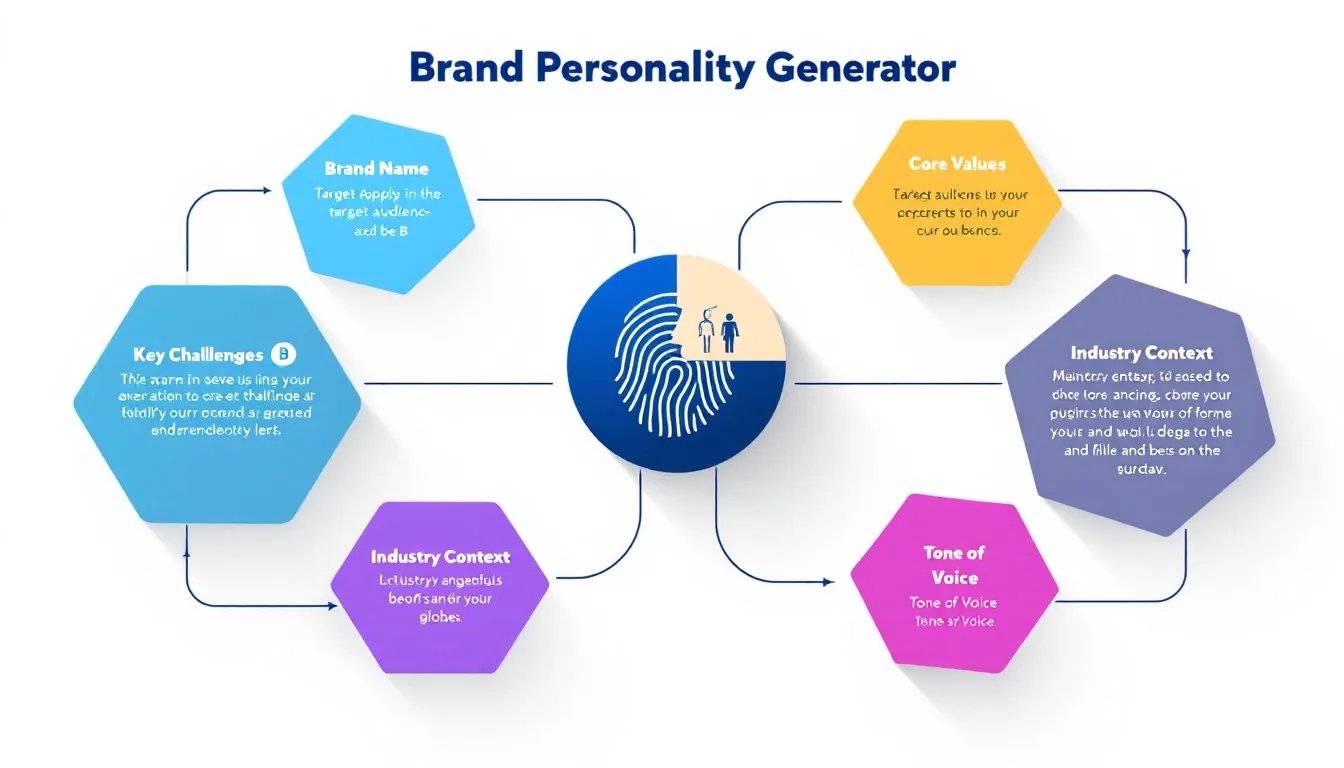Is this tool helpful?
How to Use the Brand Personality Generator Tool Effectively
Our Brand Personality Generator tool consists of six carefully designed input fields that help create a comprehensive and engaging brand personality. Here’s a detailed guide on how to use each field effectively:
1. Brand Name Field
Enter your brand name exactly as it appears to customers. For example:
- “GreenLeaf Cosmetics” – for an eco-friendly beauty brand
- “TechFlow Solutions” – for a digital transformation company
2. Target Audience Description
Provide detailed information about your ideal customers, including:
- Demographics (age, gender, location)
- Psychographics (interests, values, lifestyle)
- Behavioral patterns (shopping habits, media consumption)
Example descriptions:
- “Health-conscious urban millennials (25-40) with disposable income, interested in wellness and sustainable living, primarily shopping online”
- “Small business owners and entrepreneurs aged 35-55, tech-savvy, looking for efficiency solutions, value professional development”
3. Core Values and Traits
List 3-5 fundamental values that define your brand identity. Strong examples include:
- “Authenticity, Innovation, Sustainability, Community-focused”
- “Reliability, Excellence, Customer-centricity, Progressive thinking”
4. Challenges and Concerns
Detail specific obstacles your brand needs to overcome:
- “Establishing credibility in a saturated market, overcoming price sensitivity, educating customers about sustainable practices”
- “Building trust in digital solutions, addressing security concerns, demonstrating ROI”
Understanding Brand Personality Generation
A brand personality is the set of human characteristics attributed to a brand name. This tool helps businesses create authentic, relatable brand personas that resonate with target audiences and drive emotional connections.
Key Components of Brand Personality
- Character Traits: Defining personality attributes
- Emotional Appeals: Psychological connections with customers
- Voice and Tone: Communication style and language
- Visual Elements: Design elements that reflect personality
Benefits of Using the Brand Personality Generator
1. Strategic Alignment
- Ensures consistency across marketing channels
- Aligns team members around unified brand vision
- Creates coherent customer experiences
2. Enhanced Customer Connection
- Builds emotional bonds with target audience
- Increases brand loyalty and advocacy
- Improves customer engagement rates
3. Market Differentiation
- Distinguishes brand from competitors
- Creates memorable brand associations
- Supports premium positioning
Problem-Solving Applications
Case Study 1: Startup Brand Development
A new fitness technology startup used the generator to develop their brand personality:
- Input: “FitTech Solutions” focusing on young professionals
- Generated Personality: Dynamic, innovative, empowering
- Result: 40% increase in brand engagement
Case Study 2: Brand Repositioning
An established furniture retailer refreshed their brand personality:
- Input: “HomeStyle Living” targeting modern families
- Generated Personality: Warm, sophisticated, accessible
- Result: 25% improvement in customer satisfaction
Practical Applications and Implementation
1. Marketing Communications
- Social media content strategy
- Email marketing tone
- Advertising campaign messaging
2. Customer Service
- Support team communication guidelines
- Response templates and scripts
- Customer interaction protocols
3. Product Development
- Feature prioritization
- User experience design
- Package design and presentation
Frequently Asked Questions
Q: How often should I update my brand personality?
Regular reviews every 12-18 months are recommended, with updates as market conditions or target audience preferences change significantly.
Q: Can I have multiple brand personalities for different market segments?
While core brand values should remain consistent, you can adjust tone and messaging for different segments while maintaining overall brand coherence.
Q: How do I implement the generated brand personality?
Create a brand guidelines document, train team members, and gradually implement changes across all customer touchpoints.
Q: What makes a strong brand personality?
Authenticity, consistency, relevance to target audience, and alignment with business values are key elements of strong brand personalities.
Q: How do I measure the success of my brand personality?
Track metrics like brand awareness, customer engagement, social media sentiment, and customer loyalty programs.
Q: Can small businesses benefit from brand personality development?
Yes, brand personality helps small businesses establish strong market presence and compete effectively with larger competitors.
Additional Tips for Success
1. Research Phase
- Analyze competitor brand personalities
- Conduct customer surveys and interviews
- Review industry trends and best practices
2. Implementation Strategy
- Create detailed rollout timeline
- Develop training materials for staff
- Monitor and adjust based on feedback
3. Maintenance and Evolution
- Regular brand personality audits
- Customer feedback integration
- Market trend adaptation
Important Disclaimer
The calculations, results, and content provided by our tools are not guaranteed to be accurate, complete, or reliable. Users are responsible for verifying and interpreting the results. Our content and tools may contain errors, biases, or inconsistencies. We reserve the right to save inputs and outputs from our tools for the purposes of error debugging, bias identification, and performance improvement. External companies providing AI models used in our tools may also save and process data in accordance with their own policies. By using our tools, you consent to this data collection and processing. We reserve the right to limit the usage of our tools based on current usability factors. By using our tools, you acknowledge that you have read, understood, and agreed to this disclaimer. You accept the inherent risks and limitations associated with the use of our tools and services.







